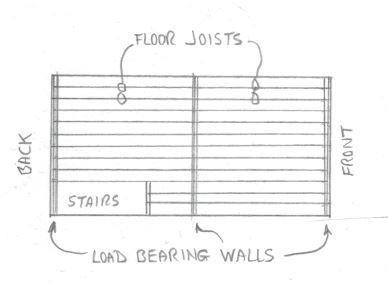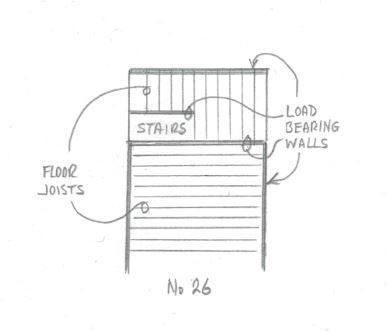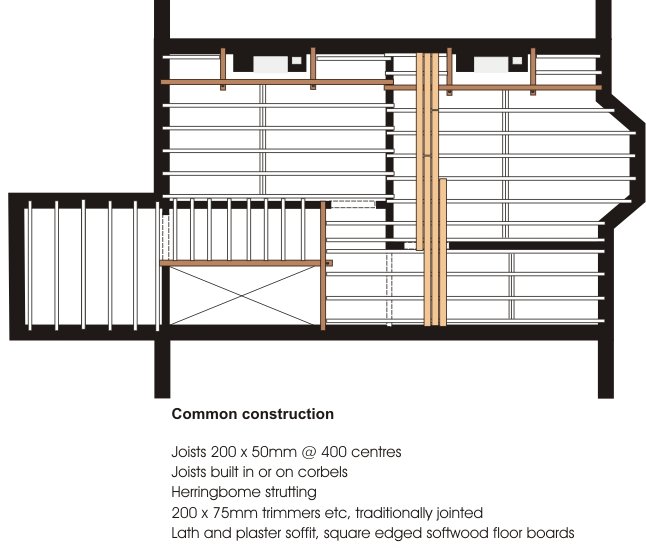Been reading the Old Bailey testimoeny and gleaned these bits of info:
The Stairs outside room 20 go up:
"Roberts knocked at the wainscotting and asked for help—Amory rushed and opened the door—he went out first—Mary Johnson followed him and then I [Jackson] went out and saw Roberts hand Amory a knife—he took it out of the prisoner's hand—I saw him—I held the lamp myself"
"when Roberts first had the prisoner there was no light—Jackson stood by the stairs which go upstairs with the lamp"
So Jackson came out of room #20 behind Johnson who had followed Amory. Jackson was at the foot of the UP stairs which go up the partition which is the wall to #20
The door to #19 opens INTO the landing:
ROBERTS "the door opens into the passage"
MARSALL: "I knew he was going to do one of us an injury, but I thought it was me, and I jumped back, when I saw his hand go to my sister, but I felt certain that it was meant for me—she never screamed, but said. "Oh, Jesus," and ran out the door, which opens outwards"
The passageway and landing are interchangeable words for the same thing:
MARSHALL: "I caught him again, and we struggled towards the door, getting out on to the dark landing—he had not got hold of my wrists than, but when we got on to the landing he had them—he tired to get my hair and my throat in the room—on the landing he put his leg behind me, and I went flat over on my back—my head was close to Amory's door—I dragged Roberto over with me—I was lying along the Passage with my feet towards my own door"
The door #20 and the partition are used interchangeably by Marshell:
MARSHALL: "my head hit the partition—I kept on screaming, but nobody came till I fell"
MARHSALL: "I did not hear Roberts call for help—Johnson and Amory never came to the door till my head struck against it"
From this bit of extra info it suggests:
the stairs from the passageway run UP against the wall that contains #13's partition and the landing is outside #19.
The Stairs outside #20 go up to the next floor.
The wall with the door of #20 is wooden and referred to as a partition.
If the stairs from the ground floor to the 1st floor run from passageway up the partition wall of #13 then the stairs that run from 1st floor to 2nd floor run the other way up and along #20's partition.
Is this a reasonable interpretation?
Prater's stairs
Collapse
X
-
Thanks all, for the positive comments...
But I'm still not satisfied!
Those stairs and their configuration are not sitting easy with me. Going to work on it a bit more.
Today I was searching for images to help me and I saw this one which made me think of the partition and the stairs going up along its length. There's even a door that would lead from the shed to #13 at the foot of the stairs

Leave a comment:
-
Well Richard, this last version you uploaded:Originally posted by richardh View PostOkay,
So how to proceed with the Goad Model? further tweaks or leave as is?
Appears to address all the witness testimony that is known and is consistent with established building practices.
We have to accept that we will never know the actual floor plan, and there could always be variations on this theme.
I should say 'we rest our case' Richard, this is as good as it is likely to get.
You've done a terrific job Richard, thankyou.
Leave a comment:
-
Of course you're right as always here, Gareth.Originally posted by Sam Flynn View PostIt could mean that the partition is at right angles to room 20, creating a "corridor" between it and room 19, and serving as the "front wall" of the storage cupboard. No reason why a partition couldn't also house a cupboard door.
Leave a comment:
-
Actually Richard, we have sketches with the floorboards running in both directions, so we can't choose one over the other on that basis alone.Originally posted by richardh View PostLooking at the contemporary sketches of #13 we can see that the artists have the floor boards running the width of the room. I take it this means the joists are running from front (Dorset Street) to back (Miller's Court)?
Does my Goad model (as it stands today) agree with this Jon?
EDIT: I don't think it does, does it?
Leave a comment:
-
Looking at the contemporary sketches of #13 we can see that the artists have the floor boards running the width of the room. I take it this means the joists are running from front (Dorset Street) to back (Miller's Court)?
Does my Goad model (as it stands today) agree with this Jon?
EDIT: I don't think it does, does it?
Originally posted by Wickerman View PostMaybe what I previously posted was too confusing, the detail below is what I saw in that floor plan. Joists running from front to back, and the stairs installed in line with the main floor joists.
Like so.

Even if the floor joists ran side to side (as I indicated with No. 26 Dorset St.) any stairs should rise up through the floor in line with the principal direction of the joists.
This is how Richard has placed them in his Goads Plan.
Leave a comment:
-
I understand now what you are saying Jon. I missed the point entirely. Sorry.
Originally posted by Wickerman View PostWhat I also saw as a point of interest was that when stairs are installed perpendicular to the run of the floor joists, a supporting wall must be included, which does not exist in Kelly's room.
That 19th century floor plan showed a stone supporting wall (black line) under the short end of the stairs. No such stone wall is inside Kelly room.
The other alternative is to build a stone supporting wall along the length of the stairs to support the cut joists. As shown here..
Example of the rear room at the back of No.26

No load bearing wall is inside Kelly's room.
The suggestion was made on this thread, that an extra set of stairs could have been built between the back wall of No.26, and the partition we see in Kelly's room.
The point I have been trying to make is that you would need something considerably stronger than a partition to support the joists which need to be cut if you want a second set of stairs outside the back wall of No.26.
Leave a comment:
-
What I also saw as a point of interest was that when stairs are installed perpendicular to the run of the floor joists, a supporting wall must be included, which does not exist in Kelly's room.
That 19th century floor plan showed a stone supporting wall (black line) under the short end of the stairs. No such stone wall is inside Kelly room.
The other alternative is to build a stone supporting wall along the length of the stairs to support the cut joists. As shown here..
Example of the rear room at the back of No.26

No load bearing wall is inside Kelly's room.
The suggestion was made on this thread, that an extra set of stairs could have been built between the back wall of No.26, and the partition we see in Kelly's room.
The point I have been trying to make is that you would need something considerably stronger than a partition to support the joists which need to be cut if you want a second set of stairs outside the back wall of No.26.
Leave a comment:
-
Maybe what I previously posted was too confusing, the detail below is what I saw in that floor plan. Joists running from front to back, and the stairs installed in line with the main floor joists.
Like so.

Even if the floor joists ran side to side (as I indicated with No. 26 Dorset St.) any stairs should rise up through the floor in line with the principal direction of the joists.
This is how Richard has placed them in his Goads Plan.
Leave a comment:
-
Richard.Originally posted by richardh View PostJon,
Could the 2nd staircase have been just wooden steps that were simply fixed to the floorboards (i'm assuming the floor in #26 was boards)
like these?

this would do-way with cutting up floor joists.
If they used this sort of thing then they only needed to smack a whole in the passageway wall to create a doorway.
Almost considered a temporary measure 'codge job'?
Here is a floor plan for a late 19th century terrace house.

The floor joists are white, and run from left to right, at either 12" or 16" centers.
The large open rectangle at bottom, just left of center is the opening for stairs coming up through the joists.
Notice the stairs enter in line with the length of the floor joists, not perpendicular.
Even if the stairs were bolted to the concrete floor (as you offer), you still need to cut out a section of joists so you can walk up through the ceiling.
This diagram shows how to do it the right way.
If stairs were installed across the 'partition wall' in Kelly's room they will run perpendicular to the joists, which is wrong.
This picture also shows how many joists would need to be cut short in order to install stairs perpendicular to those smaller joists (I can see this may be confusing).
I used this picture because it gives examples of the two problems we are discussing, but on reflection, maybe not a good idea.Last edited by Wickerman; 01-06-2016, 06:17 PM.
Leave a comment:
-
Intangibles
What amazing work Richard, in trying to deconstruct/reconstruct intangibles. I'm in awe & I have a migraine just considering it.
Leave a comment:
-
Really impressive work with the 3D images, I don't know if this helps but this article suggests the archway stairs lead to a landing with access to two rooms.
Maybe little clues in various newspapers will solve the layout for you in time

Leave a comment:
-
May I just congratulate you on all your work on this, richardh. You must have the patience of a saint.
I tried to construct this building in Second Life a few years ago and got myself in a right muddle with the stairs. At one point I flipped it all upside down, added some flamingos around it and went to bed in a huff!
I have been following this thread with great interest and am very impressed at your efforts. It has all been very fascinating indeed.
Leave a comment:


Leave a comment: